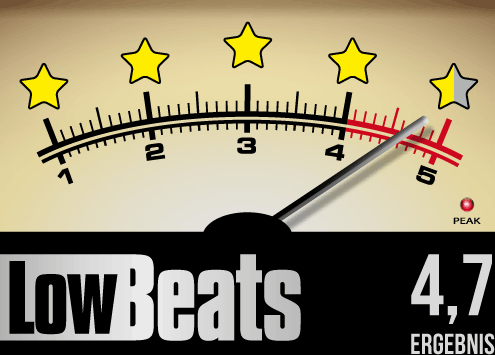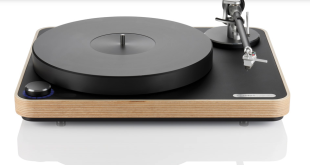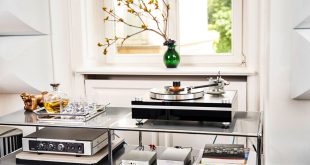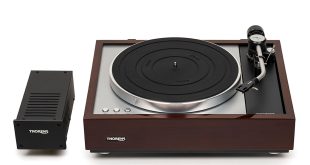The Acoustic Signature Verona NEO is a top-quality turntable in the guise of a normal record player. In the test, it impressed with its well thought-out practical features, high flexibility and powerful, generous sound.
The Verona NEO is a little out of line with the Acoustic Signature drives. The Swabian manufacturer calls the design “retro” – because the platter and tonearm bases do not stand alone and exposed in the room, but are framed by a classic rectangular frame. Their composition should – gulp! – even involve wood. A rather unusual material for the German company, which annually feeds tons of the finest aluminum to a hungry, state-of-the-art machine park, as well as somewhat smaller quantities of brass and stainless steel. But OK, then I’m just retro. Because this is by far my favorite player from my former home town of Göppingen. As I will explain in a moment, there are sound-related reasons for this, but there are also very practical ones. And in terms of price. The Verona Neo may be expensive, but for 12,000 euros as a pure drive it is not yet completely out of the question. And it offers massive value in terms of sound, mechanics and appearance.

The practical reasons: I prefer players where the platter, arm and pickup are on a common surface on which my hand can rest when moving the tonearm. I can simply hang up faster, more precisely and more safely. And even if the Verona is not a DJ player and my listening room is not a club, there are always situations in which I don’t listen to one complete side after the other in peace and quiet. Frame players like the Verona simply offer better ergonomics than analog drilling rigs and space stations – which of course also have their aesthetic appeal. Anyone who thinks of a hollow, furniture-like cabinet that merely conceals the player technology underneath is not very familiar with Acoustic Signature and its boss Gunther Frohnhöfer.
The special features of the Acoustic Signature Verona NEO
Like almost all models from Süßen near Göppingen, the Verona requires a pallet, because even without packaging, without arms and power supply unit (but with platter) it clearly exceeds the 30 kilos that normal parcel services can just about expect their drivers to carry. Two thirds of this mass rests in the chassis. Which, by the way, looks extremely attractive live, in a discreet, confident way. With balanced proportions and exactly the right chamfers, angles and surfaces in the right places. A design that immediately makes it clear: either the boss is not only a mechanical engineer, but also a brilliant industrial designer, or he has commissioned one to fine-tune the design of his recordplayer creations. The latter applies to Acoustic Signature.

One hundred percent Frohnhöfer lies beneath the beautiful surface, which shines in either high-gloss lacquered Makassar veneer or black piano lacquer. Namely several layers of steel, multiplex and MDF. Materials with very different damping and sound conduction properties that neutralize each other in a firmly bonded sandwich. Constrained Layer Damping or CLD is what engineers call this, a tried and tested means of reducing vibrations. A few cavities are milled out of the 6.5-centimeter-thick CLD block, which has a footprint of 45 x 55 centimeters: There are openings for two tonearms and their bases and cables on the right and left at the back. And a deep recess in the middle that accommodates the drive.
If you unpacked the Verona, you might mistake it for a direct-drive player. This is because its motors are just as invisible as most of the inner plate they drive. Its mighty central hub protrudes upwards through a bolted aluminum cover to receive the ten-kilo main platter. The rest of the drive is virtually sealed below deck, and the owner only has to open the engine room once in a blue moon to put on two fresh drive belts. The assembly is then very simple: set up the chassis, place the plate on it, then put the spirit level on it and balance it meticulously horizontally. The Verona is one of the very few players for whom this balancing is not sweaty or frustrating, but a real pleasure. This is due to the three huge, gel-filled shock absorber feet, which are not only perfectly accessible at the front left and right as well as at the rear center, but can also be turned in and out amazingly smoothly, actually with one finger. Of course, this is not witchcraft, but the result of a large radius, a non-slip shape, precisely cut threads and a screwdriver tip of the right grease. Nevertheless, only a few manage to do it so beautifully.

Once balanced, the turntable can be fitted with the existing or purchased tonearms. Sure: plural. Namely two. If you want, you can of course also operate the Verona with one arm. In this case, one of the two solid aluminum terraces in the rear half of the player remains empty, and Acoustic Signature will be happy to drill and mill it later (but not for free) to fit every conceivable arm. My test specimen came with two SME-style slotted bases, drilled for the pivot-to-spindle spacing of the in-house twelve- and nine-inch arms. The beauty of the Verona – or one of its many beautiful features: The player has an absolutely symmetrical design, and arms of any length fit in both positions. This means that the user is completely free to decide which swivel is parked on the right along the outer edge and which is parked at the rear left and extends from there to the right along the rear edge of the chassis when not in use. The former position is ergonomically more favorable, which is why the main arm is normally positioned there. But you can swap the placement of the existing bases at any time if your preferences change.
To avoid boredom, Acoustic Signature sent me two arms that not only differ in length, but also come from two different quality levels of the manufacturer. What has been true of every Acoustic Signature arm I’ve had my hands on so far applies to both: They are immaculately crafted sound tools with a well thought-out, practical design that, like the turntables, are built entirely in Süßen. And not just assembled, but milled from aluminum part by part using state-of-the-art CNC machines and then assembled, adjusted and tested by experienced employees with admirable calm. The Swabian company has serious vertical integration and really does do almost everything itself. External companies are only needed for a few very special jobs and parts. For example, to apply a diamond coating to the axle of the disk bearing, which ensures almost surreal wear and sliding properties. This process is called DLC – for “Diamond Like Carbon”, Acoustic Signature calls the resulting bearing “Duraturn Diamond Bearing” or DTD.
The right drive
Another Acoustic Signature specialty with its own abbreviation is AVC, the “Automatic Vibration Control” in the power supply for the drive motors. There are two of the latter in the Verona: long-lasting, classic synchronous motors, each running with two phase-shifted sinusoidal alternating voltages. AVC generates these alternating voltages digitally, monitors the motor running and continuously adjusts the phase position to prevent vibrations from occurring in the first place. In fact, the Verona is one of the smoothest running players I have ever had in my listening room. And what this calmness does to the sound is both pleasing and unexpectedly clear. The dynamics of the player become huge, and change from a punctual dynamic that favors certain frequency ranges to an all-encompassing power that is just as effective in the low bass as in the most remote overtones. This really does make the music sound bigger, and – at least in my listening room – transforms the entire system into a more convincing, more engaging version of itself. And this has nothing to do with the tonearm or cartridge, but is a quality that the turntable brings with it and passes on to any adequate arm and pickup.

I wouldn’t say that without a meaningful comparison. I had one, in the form of the SME Model 10, a turntable that was replaced only a few years ago and combines compact dimensions and manageable weight with highly stable sound. At least until someone puts an SME 20 or the Acoustic Signature Verona Neo next to it. Against my Linn LP12, the SME usually plays itself into a stalemate, whereby its stoic calm and stability speak in its favor, but the Linn’s perceived greater dynamics. It’s a different story with the really big rivals, and the findings are also more meaningful because they can be obtained with identical tonearm configurations. Conveniently – and unsurprisingly – SME also uses the SME mounting standard for its arms. This means that my SME 309 can be transferred from its original ten to the Verona in just a few simple steps.

OK, there are a few more handles because Acoustic Signature uses a slightly longer mounting distance for its arms. However, this is within the generous adjustment range of the ingenious SME carriage. So you crank the arm forward a few millimeters on the Verona and voilà: perfect overhang.
Hearing test
What I then got to hear was already alarmingly close to my idea of perfect LP sound. And makes the magnificent SME seem almost small and a little insecure next to it, but above all less dynamic. Even the Linn (with Ekos tonearm, Lingo power supply and Kore sub-chassis) can’t compete with the powerful thrust developed by the Acoustic Signature. Perhaps it could in the latest expansion stage – which I don’t have. However, even the latest production models below the top model are likely to have a hard time. It’s not often that I sit alone in the listening room on a weekday morning, lean back with a broad grin on my face and simply turn up the volume a little more. With “End”, the 2023 album by Texan post-rockers Explosions In The Sky, for example, Verona manages to blow away everyday life with pure energy. On “End”, the band is more rocking, straighter and more compact than on the older albums, which were more deliberately structured. The high dynamics of the pieces, the triumphant drum inserts and the exuberant intensity have been retained.

The sound of the record is both concrete and solid via the Verona and, especially in the parts with multiple guitar tracks, fascinatingly finely fanned out. While listening to it, I was reminded of a visual equivalent from a 1970s decoroations poison cabinet: these bouquets of glass fibers, which, illuminated by a central light source, fray into sparkling spheres of tiny points of light – colored, of course. Listening to the Verona sometimes feels like sitting inside one of these light objects.
Especially with high-resolution cartridges like the Transrotor Figaro, the best Goldring that Goldring never built under its own name. The tweeter’s diligence sometimes seems almost exaggerated. But like the similarly open Lyra Delos, the Figaro doesn’t sound bright at all in really good arms and on really good turntables, but simply enormously informative. So informative that overtone rows or guitar strings glow around the listener like meteor showers. If you’re starting to get the impression that the author is drifting away from reality, you might just have to listen to Verona NEO. And not just on any amplifier. But on the Rike Audio Natalija 2, a phono pre with wonderfully unforced dynamics and an organic, natural sound, followed by the fantastic Soulnote A-1 integrated amplifier. Other combinations are also possible. However, I currently find it difficult to find anything comparable to the Soulnote, even for considerably more money.
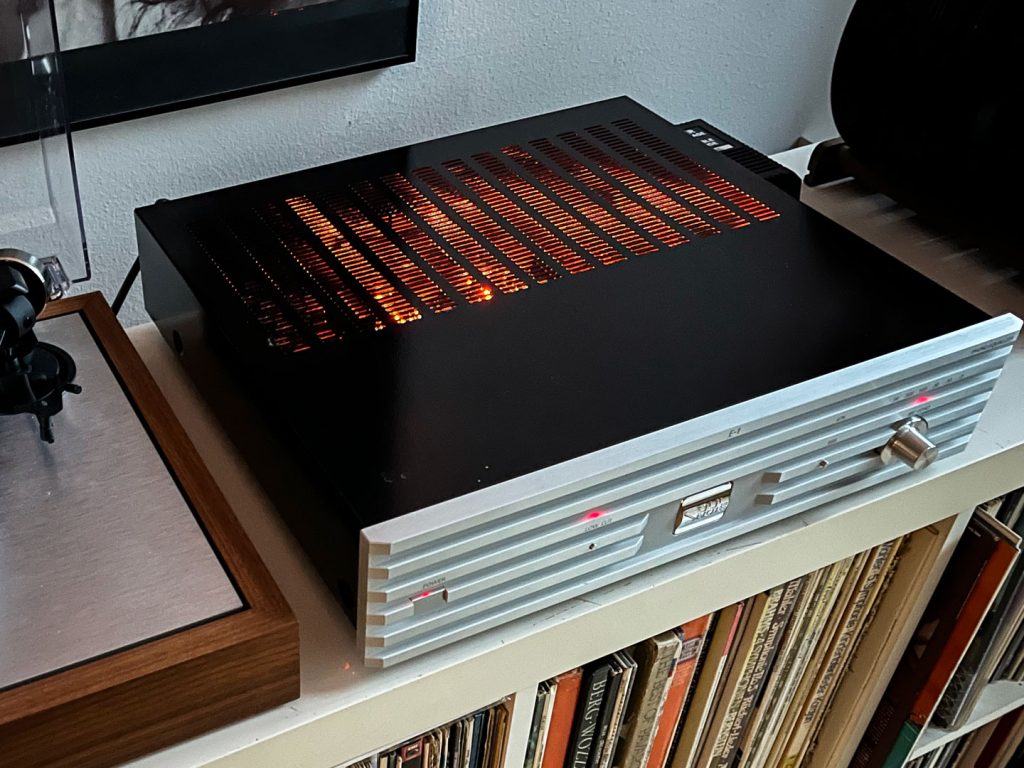
Heavyweight turntables, of which the Verona is one, do not always fulfill the expectations that one intuitively has in view of their habitus: sometimes, players weighing a ton can sound disappointingly thin-lipped and stiff. There is no sign of this in the Verona. This Swabian is not a Prussian in disguise, but makes music with heart and sensuality. A quality that cannot be ignored, even in comparison with the smaller Tornado, for example. At first glance, it doesn’t seem that much smaller – until you look at the specs: The Verona has the much more complex chassis, two motors instead of just one, the large DMC-20 digital power supply – and the “grosse Däller” (Swabian dialect for “big platter”), as the Süßener would say. More precisely: a plate that is no thicker and only slightly heavier than that of the Tornado, but has a larger number of silencers. These are solid brass cylinders in full plate thickness, which are driven into precisely fitting holes in the plate with a soft-face mallet. Once in place, they calm the resonance of the aluminum platter so effectively that it only emits a listless “tic” during the tapping test instead of the practically endless “tinggggggggggg” that usually characterizes one-piece aluminum platters.

As already mentioned above, Acoustic Signature has also included high-quality arms: The TA-2000, here in a nine-inch version, is the big brother of the TA-1000, which we liked very much on the Tornado. It comes with even finer bearings in an even more solid gimbal and the convenient anti-skating with spring and rotary control. At first glance, the TA-5000, which we received as a twelve-inch model, looks expensive. Its arm tube has a large caliber and consists of three concentric carbon fiber layers with damping intermediate layers. The front end of the tube is a magnificent headshell milled from a single piece of solid material. At the rear, the boom ends in a massive bearing ring with hybrid ball bearings from the German manufacturer SKF, which combine steel bearing rings with rolling elements made of silicon nitride ceramic.

When I look at the price of the tonearm, my eyes sting for a moment: 6300 euros for the nine-inch version, 900 euros more for the twelve-inch version. But this is currently only the third-largest arm model of the Süßener. And that’s only if you don’t count the extreme swinging TA 10000, which will round off the range above the 21,000 euro TA-9000 from the 2024 High End.

Against this background, it makes sense why the manufacturer still considers the 5000 to be one of the most fairly priced models. After all, anyone with the necessary small change can buy it. Not like SME, whose “modern” V, IV and 3xx series arms are simply no longer available. Because SME has decided, after decades on the market, to suddenly only sell them together with its own drives. Frohnhöfer is probably pleased.
You can read more about why twelve-inch arms have advantages and potential disadvantages over their full-length nine-inch siblings, and exactly what these are, in my story on the Acoustic Signature Tornado Neo, which focuses on this aspect. The listening comparisons were made with two TA-1000s. But even a TA-5000 is slightly less stiff in long than in short. It’s just that the difference is now somewhere between “super stiff” and “extremely stiff”, so it’s much more negligible than with the thinner arm tube of the 1000. The geometric advantages, on the other hand, remain fully intact and can be heard even more clearly with the large arm: even somewhat more delicate systems such as the Transrotor mentioned above play richly, lushly and completely distortion-free in the TA-5000.

The TA-5000 is an inspiring, highly musical arm. For example, when he plays “The End Of Days”, the latest album by British songwriter Matt Elliott. The six songs are hard to beat in terms of darkness, but offer a feast for the ears and soul. The title track begins – as is often the case – with Elliott’s concert guitar, which introduces the theme in a wonderfully woody, fragrant tone. Then Elliott sings along with his gentle bass voice, which is miked very close and therefore fills the room larger than life. He is somewhat reminiscent of the late Leonard Cohen before woodwinds finally take over, while double bass and grand piano continue to accompany. The horns could be several Elliott tracks, as he is the only one with “Sax” in the credits. I also think I hear a clarinet, or maybe it’s a clarinet-like sounding saxophone. In any case, these united wind instruments intonate a lament of almost galactic heaviness that hypnotically lulls the piece to a close over the last few of its ten minutes. Then, on the five following pieces, it gets even darker.

What stands out with the TA-5000 is the wonderfully sonorous tone of the horns and Elliott’s voice, the perfect proportions of the concert guitar – not too lean, not too fat or even boomy – and the rather unexpectedly vital dynamics on such a quiet record. For example, when bassist Jeff Hallam snaps a string against the fingerboard, or pianist and producer David Chalmin lets out a somewhat louder note. What also comes across intensely is the great acoustics and paradisiacal tranquillity of Chalmin’s secluded studio country house in the Pays Basque. The Acoustic Signature extracts a great density, atmosphere and presence from the grooves of Optimal’s exceptionally well-pressed record.
And yet there remains a remnant of recognizable character in the sound of the TA-5000. Which doesn’t bother, especially as this character fits in very well with the overall tuning: In the polyphonic woodwind funeral march, for example, the saxophones take on a funnel full of extra warmth. And the doomsday male choir that begins in the next track (I wrote: it gets darker) also deviates a little towards volume from the center track of complete neutrality. Although much less pronounced and with an overall higher level of dynamics and resolution, this is reminiscent of the sound of the twelve-inch TA-1000, which also sounded somewhat woollier than its short buddy. Even without quickly ordering a short TA-5000, I would bet that it plays a little tighter and faster. If that’s what you’re looking for – great!
On the other hand, the twelve-inch speaker retains the huge space and the accurate contours within this space perfectly, something that the long 1000 speaker achieved far less perfectly. This cinemascope width and the slightly warm tone go together wonderfully. Which is why I wouldn’t put the TA-5000-12 with the finest possible resolution MC in the rear left seat, but in the standard rear right seat. Where I can easily reach from the listening position without having to bend. And then what goes in the free space at the back? That depends on the usage behavior. If you don’t need a second arm at the moment, order the player with an undrilled second base and enjoy the feeling of being able to expand at any time, but not having to.

For all those who still have an SME at home or can get their hands on one, it should be added that the 309 sounds absolutely fantastic on the Verona Neo and looks really good too. It will hardly be any different with fours or fives. Unlike “my” nine-inch base – which was actually milled for AS’s own arms – the Swabians will mill an explicitly ordered SME base exactly to the tenth and provide it with fastening threads. The same applies to Linn, Rega and any other arms with their mounting standards. This means that the Verona NEO can be used to create countless stylistic and tonal variations. The drive forms an unshakeable, incorruptible foundation for everyone that, realistically speaking, you never have to think about again.
Conclusion Acoustic Signature Verona NEO
German heavyweight drives are also available with a variety of individual sound characteristics. In a positive sense, the Verona NEO sounds different from most other heavyweights: it forms a powerful, large-format sound foundation that even sub-chassis fans will get their money’s worth. And on which the qualities of the assembled arms and systems can be optimally expressed. It would therefore be a bad idea to save money on the bracelet. In the event of a budget shortage, we would prefer to start with the best possible arm instead of two compromises.

The manufacturer itself offers a wide range of top arms and will mill the second base to fit at any time if and when a second arm is chosen.
Rating
Sound QualityUsabilityBuild QualitySummary |
| The rating always refers to the respective price category. |
| | An unusually lively, powerful sound for a heavyweight drive |
| | Sensationally smooth running |
| | Extremely flexible in terms of tonearm configuration |
| | Outstanding workmanship, uncomplicated and undemanding in everyday use |
Distribution:
AS-Distribution GmbH
Hillenbrand Street 10
73079 Suessen
www.acoustic-signature.com
Price (manufacturer’s recommendation):
Acoustic Signature Verona NEO: from 12,000 euros
Acoustic Signature TA-2000 NEO: from 3,000 euros
Acoustic SignatureTA-5000 NEO: from 6,300 euros
Additional arm base + armboard as required: 700 euros
Technical data
| Acoustic Signature Verona Neo | |
|---|---|
| Concept: | Heavyweight drive, belt drive |
| Fitting | Up to two tonearms possible |
| Turntable: | 310 mm, 11 kilos with 8 silencer pins |
| Chassis: | 65 mm thick sandwich construction made of MDF, steel & multiplex |
| Drive: | Speed-regulated double-belt drive with fine speed adjustment for subplates |
| Speeds: | 33 + 45 rpm |
| Dimensions (W x H x D): | 54.4 x 16.6 x 44.9 cm |
| Weight: | 33.2 kilos |
| All technical data | |
With and against:
Test MM/MC phono preamp Soulnote E-1
Test: MM/MC phono preamp Rike Audio Natalija
 More from Acoustic Signature:
More from Acoustic Signature:
Test turntable Acoustic Signature Tornado Neo with 2 x TA-1000 Neo and MCX-4




